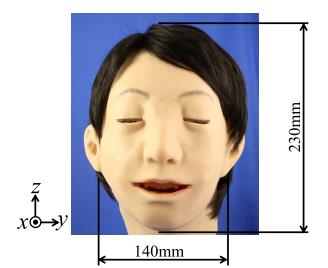
WKH-4
(Waseda Kyotokagaku Head-No.4)
1. Introduction
The examination of the facial muscles is one of the procedures of the cranial nerve examination. In this examination, a medical doctor asks a patient to express three different types of facial expressions to find problems in the cranial nerve of the patient. We have been developing training simulators for the cranial nerve examination, which are facial robots with functions to mimic disorders of the cranial nerve such as stroke. The key point to design the facial robots is expressions of wrinkles. We then developed WKH-4, which had new mechanism to express the wrinkles on its face.
▲Top page
2. System
The new mechanism to express wrinkles consists of an artificial facial skin, grooves under it, and a compressor to vacuum air between the facial skin and the grooves (Fig. 1 and Fig. 2). Once the air pressure in the groove is decreased, the artificial skin around the groove deforms to along with the shape of the groove. This mechanism was implemented at the head, eyebrow, and mouth corner of WKH-4, to express the wrinkles. In addition, other mechanisms for driving the eye, jaw and rip was implemented. Facial expression and wrinkles are then expressed by synchronized motion of these mechanisms.

Fig1.Wrinkle mechanism

Fig2.System of wrinkle control
▲Top page
3. Movement
The movements of WKH-4 are shown in the movies.
Wrinkling up at the forehead |
|
Clenching the eye |
|
Lifting the mouth corner |
|
Patient(Wrinkling up at the forehead) |
|
▲Top page